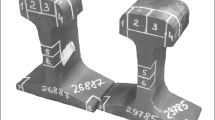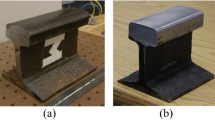The research investigates the structure of a welded joint of a railway rail after local heat treatment and without it. Macro- and microstructural analyses of rail samples were performed using optical microscopy methods. The hardness of the rail running surface in the heat-affected zone of butt welds was measured. It has been found that the formation of zones with reduced hardness is inevitable due to the temperature gradient created during the welding process. Moreover, using local induction heat treatment results in the formation of new, more extended zones with reduced hardness. It has been determined that the only solution to this problem is to reduce the extent of heat-affected zones to sizes that do not lead to increased wear and local crushing.






Similar content being viewed by others
References
V. V. Chesnokov, “The keynote speech by the Chief engineer of the East Siberian infrastructure directorate,” in: Improving the Quality and Operating Conditions of Rails and Rail Fasteners (Based on the Meeting of the Non-Commercial Partnership “Rail Commission,” September 7 – 9, 2016), Collection of Scientific Reports [in Russian], UIM, Ekaterinburg (2016), pp. 10 – 11.
A. I. Lisitsyn and I. A. Kuznetsov, “An analysis of the operation of rails of new categories on the Russian railway network and promising lines of work to improve their reliability,” in: Improving the Quality and Operating Conditions of Rails and Rail Fasteners (Based on the Meeting of the Non-commercial Partnership “Rail Commission,” 7 – 9 September 2016), Collection of Scientific Reports [in Russian], UIM, Ekaterinburg (2016), pp. 15 – 23.
V. A. Rezanov, Developing a Flash Method for Resistance Welding of Alloyed Rails, Author’s Abstract of Candidate’s Thesis [in Russian], Moscow (2013), 140 p.
N. A. Kozyrev, R. A. Shevchenko, A. A. Usoltsev, et al., “Developing and modeling the technological process of welding differentially heat-strengthened railway rails. Modeling of processes occurring during welding and local heat treatment,” Izv. Vysh. Uchebn. Zaved., Chern. Metall., 63(2), 93 – 101 (2020).
P. E. Sazonov, “Specific features of welding new types of rails of the DT350, DT370IK categories,” in: Improving the Quality and Operating Conditions of Rails and Rail Fasteners (Based on the Meeting of the Non-commercial Partnership “Rail Commission,” September 25 – 27, 2015), Collection of Scientific Reports [in Russian], UIM, Chelyabinsk (2015), pp. 189 – 192.
A. I. Nikolin, Improving the Processes of Welding and Heat Treatment of Rails of Trunk Railways, Author’s Abstract of Candidate’s Thesis [in Russian], Moscow (2004), 200 p.
S. I. Zhuravlyov, A. Ya. Sudarkin, L. S. Sergeyev, and A. B. Korolyova, “Technological capabilities of smart equipment for flash butt welding,” Svarka Diagnost., No. 3, 51 – 56 (2009).
A. I. Lisitsyn, “Current requirements for rail products supplied for OJSC Russian Railways,” in: Improving the Quality and Operating Conditions of Rails and Rail Fasteners (Based on the Meeting of the Non-Commercial Partnership “Rail Commission,” September 25 – 27, 2015), Collection of Scientific Reports [in Russian], UIM, Chelyabinsk (2015), pp. 84 – 94.
G. Girsch, J. Keichel, R. Gehrmann, et al., “Advanced rail steels for heavy haul application-track performance and weldability,” in: Heavy Haul Conf., Shanghai, China, June 22 – 25 (2009), pp. 171 – 178.
P. Mutton, J. Cookson, C. Qui, and D.Welsby, “Microstructural characterisation of rolling contact fatigue damage in flashbutt welds,” Wear, 366, 368 – 377 (2016).
Yu. M. Lahtin, V. P. Leontiev, Materials Science, Textbook for Technical Higher Education Institutions [in Russian], Mashinostroyeniye, Moscow (1990), 528 p.
T. Oyama, O. D. Sherby, J. Wadsworth, and B. Walser, Scr. Metall., 18, 799 – 804 (1984).
T. Nakano, H. Kawatani, S. Kinoshita, Trans. Iron Steel Inst. Jpn, 17, 110 – 115 (1977).
G.-H. Zhang, J.-Y. Chae, K.-H. Kim, and D. W. Suh, Mater. Charact., 81, 56 – 67 (2013).
Author information
Authors and Affiliations
Corresponding author
Additional information
Translated from Metallovedenie i Termicheskaya Obrabotka Metallov, No. 6, pp. 40 – 46, June, 2022.
Rights and permissions
Springer Nature or its licensor holds exclusive rights to this article under a publishing agreement with the author(s) or other rightsholder(s); author self-archiving of the accepted manuscript version of this article is solely governed by the terms of such publishing agreement and applicable law.
About this article
Cite this article
Shevchenko, R.A., Yur’ev, A.B., Kozyrev, N.A. et al. Patterns of the Formation of Reduced Hardness Zones in a Welded Joint of Railway Rails. Met Sci Heat Treat 64, 332–337 (2022). https://doi.org/10.1007/s11041-022-00810-0
Received:
Published:
Issue Date:
DOI: https://doi.org/10.1007/s11041-022-00810-0




